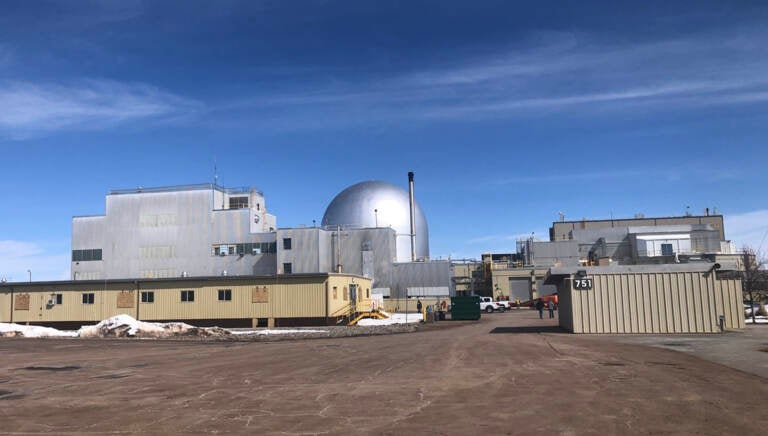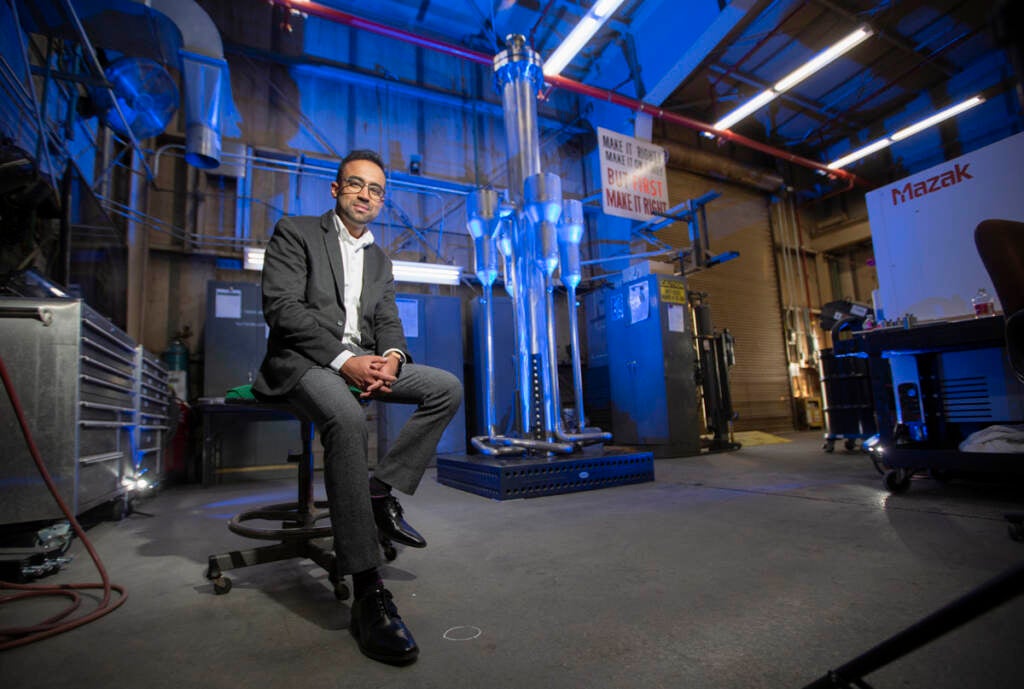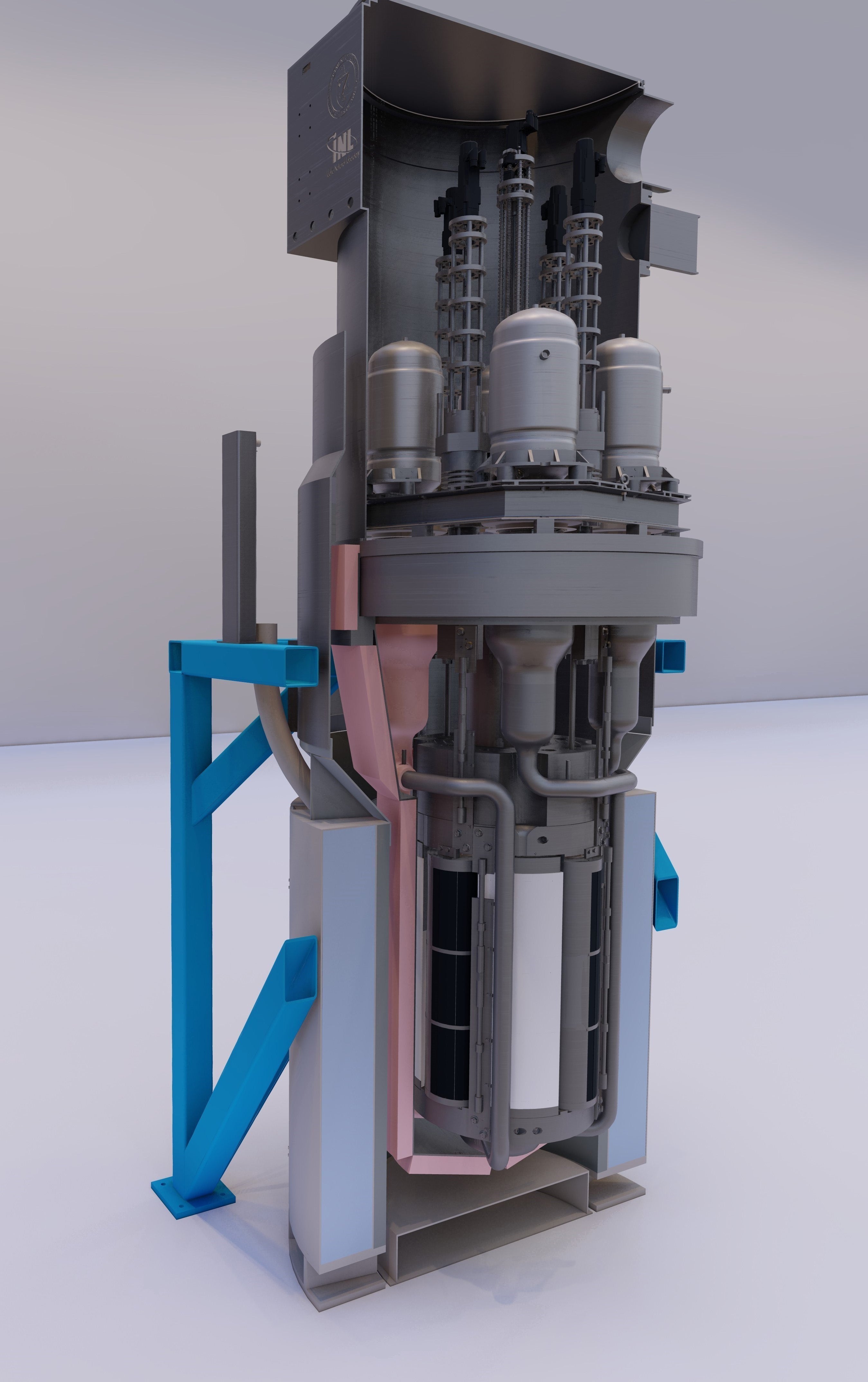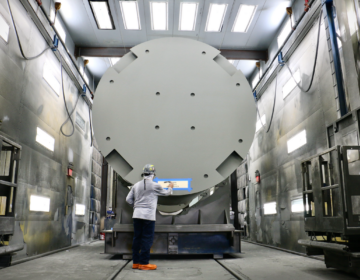Will climate change force the future of nuclear energy to look smaller and more mobile?
A new microreactor being developed at the Idaho National Laboratory will be small enough to put on a tractor trailer and nimble enough to send to a disaster site.
Listen 8:05
Idaho National Laboratory builds and tests nuclear reactors that are often housed in silver domes in the high desert area. (Susan Phillips/WHYY)
This story is from The Pulse, a weekly health and science podcast.
Find it on Apple Podcasts, Spotify, or wherever you get your podcasts.
Giant cooling towers pour out steam and send megawatts of electricity through interstate power lines to hundreds of thousands of homes. That’s the current image of nuclear energy based on massive projects from the 1970’s and 1980’s. The behemoth power plants often went over budget, and generated fears of radiation leaks after the partial meltdown of a reactor at the Three Mile Island nuclear plant in Pennsylvania in 1979. Since then, many have shut down, and others are scheduled to retire in the coming decades.
Today, nuclear advocates say the future of atomic energy looks very different and with climate disasters piling up on our doorsteps, absolutely essential. Currently, nuclear power provides about half of the country’s carbon-free electricity.
“Small but mighty,” the new push to develop micronuclear reactors means small enough to put on a tractor trailer, and nimble enough to send to a disaster site, or a remote village in Alaska.
That’s the goal of a new reactor being developed at the Idaho National Laboratory.
“What we’re talking about here is historic in the U.S. and urgent in terms of demands for clean energy,” said John Wagner, director of the Idaho National Laboratory, which is run by the Department of Energy.
The Idaho National Laboratory sits on the flat, high desert of the state’s southeast corner, about 100 miles southwest of Yellowstone.
Stretching for almost 900 square miles, it’s about three-quarters the size of Rhode Island, and not much more than sage brush covers the dusty land. Snow-capped volcanic buttes rise suddenly from the terrain, breaking up the monotony, along with silver domes that house nuclear reactors.
It’s at this sprawling facility, in 1951, that the first electricity generating nuclear reactor was built and tested – illuminating four light bulbs.
Since then, 52 nuclear reactors were built and tested at the site – the last one in 1973.
Fast forward 50 years and now engineers at the Idaho Labs are developing what they say will be a much smaller, safer, and portable nuclear reactor. They call it MARVEL or the Microreactor Applications Research Validation and EvaLuation.
“The first few reactors are going to be very, very small. They’re going to be involved in learning how to do this again and demonstrating the technologies to provide confidence for future deployments,” Wagner said.
Subscribe to The Pulse
The MARVEL micronuclear reactor is the brainchild of 36-year-old Yasir Arafat, a nuclear engineer and chief designer.
“We’re going to try to figure out how we extract heat and energy from a nuclear reactor and apply it and combine it with solar and wind and other energy sources,” Arafat said.
Application, or using the reactor not simply for testing purposes, is key, Arafat said
Standing inside the large windowless building known as the Transient Reactor Test Facility, Arafat describes the project as “small but mighty.”
The reactor itself is tiny — at least in the world of nuclear power. It will be about the size of a sedan, small enough to fit onto the back of an 18-wheeler.
Weighing about 2000 pounds it will be made up of 3800 parts and built from scratch here at the Idaho Labs.
Unlike the massive nuclear projects of the past, the MARVEL is designed to provide carbon free energy to remote areas not attached to any power grid. Remote locations that often rely on dirty diesel engines.
“When we turn on the light switch in our homes, it turns on right away,” Arafat said. “So, we take it for granted after a while, but it’s not the same for the remainder of the world. There’s about 7 billion people on this planet. And about two and a half billion out of seven do not have access to electricity.”

He says there are three key advantages to this new design.
“We can build them in factories the way we make cars. We can transport them on standard roads. And the third, which is the most important one, they have to be self-regulating. They have to be so automated that we don’t require human interaction to actually ensure they can be run safely, and they can be run properly and reliably.”
Safety, of course, is what comes to mind for most people at the thought of trucking a nuclear reactor down a highway or putting one in a small village in Alaska.
Arafat says the fuel for the MARVEL is the same fuel used at about two dozen universities across the country that have had test reactors for decades. And because of the reactor’s size it doesn’t need a containment building. The radioactive fuel rods are protected with several layers of stainless steel.
“Everything remains intact, no matter what the condition is, whether you have an earthquake, whether you have a pipe break or a major leak, whether you have loss of power, under any of these circumstances, the reactor remains as benign as a university research reactor.”
But not everyone agrees.
“It’s utterly insane and likely to go nowhere,” said Ed Lyman, a physicist and director of nuclear power safety for the Union of Concerned Scientists.
Lyman, an expert in nuclear power safety and security, says it’s a “myth” that these microreactors could be safer than any other type of reactor, both from a meltdown, or from sabotage, and he says they’re cost prohibitive, so it’s just not worth it.
“DOE really shouldn’t be doing this,” he said.
The danger with nuclear power is overheating. Unlike a coal or natural gas plant, even if you turn off a nuclear plant the heat continues to get generated. That’s why large nuclear plants are located near a body of water, it’s a convenient coolant.
But the primary coolant for the MARVEL reactor is a liquid metal that does not need mechanical parts but instead relies on natural circulation. Any excess heat is cooled by air.
“Why is that important? Because air is everywhere,” Arafat said. “Basically, when you put this reactor anywhere, you turn it off. You don’t have to worry about providing active cooling. The air will naturally cool it down.”
He says even if there is a meltdown, there would be no consequences.

Doug Crawford runs the Transient Reactor Test Facility at Idaho National Laboratory where his job is to cause meltdowns at the test reactor. He says after 70 years, nuclear engineers have learned that it’s better to design a system that has the least amount of human interaction possible — in other words, it’s an automated system that has what they call “passive safety response” — including natural phenomena like gravity or conduction.
“A reactor that’s safe passively doesn’t need a pump to turn on, it doesn’t need a person to go flip a switch,” Crawford said. “We can design our reactors in our systems to take advantage of the laws of nature.”
The MARVEL will produce 100 kilowatts of thermal energy using uranium-zirconium hydride, also known as TRIGA fuel. It will generate about 20 kilowatts of electricity, enough to power 10 to 20 homes. The lab does not develop technology for its own use, but to share it with U.S. companies that would develop it at scale.
Arafat admits, building a microreactor is not easy.
“My hope is companies would actually take this leveraging technology and actually be able to come up with commercial versions that can be cost competitive with solar, wind, and oil and gas and be able to deploy them everywhere. That jump is not an easy jump.”
The cost is about $81 million for design, construction, two years of operation and decommissioning, according to Idaho Labs. The fuel and the reactor will cost less than $15 million. Arafat says that’s modest for a nuclear reactor, and since it’s the first one, others that can be factory built will cost less.
“The way I see the future, we’re going to be making these microreactors so safe, so benign, but also economically feasible that it can be widespread around not just the U.S. but around the world.”
The lab plans to complete the MARVEL reactor next year when it would power the world’s first nuclear microgrid at the site.
WHYY is your source for fact-based, in-depth journalism and information. As a nonprofit organization, we rely on financial support from readers like you. Please give today.






